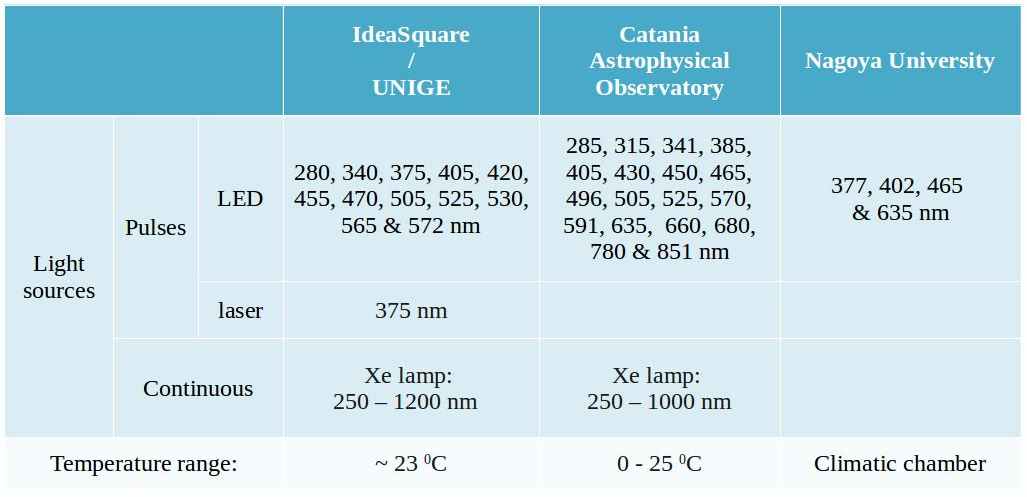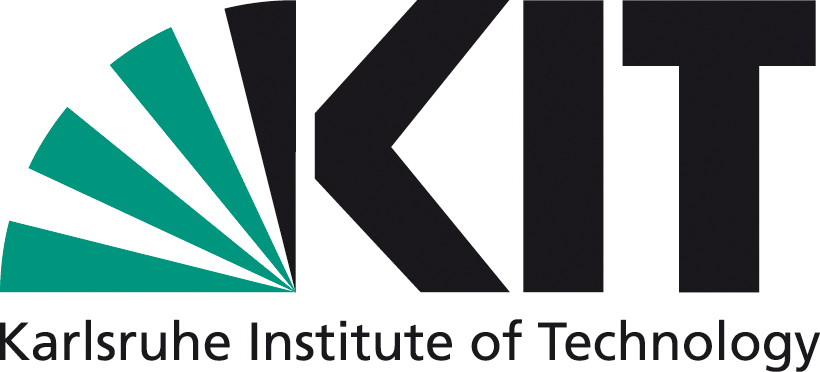Experimental setup of UniGE at IdeaSquare
 The experimental setup at the IdeaSquare, CERN was build and calibrated in collaboration with Geneva University for electrical and optical characterisation of various SiPM devices at room temperature.
The experimental setup at the IdeaSquare, CERN was build and calibrated in collaboration with Geneva University for electrical and optical characterisation of various SiPM devices at room temperature.
In the context of SENSE a collaboration between several labs experienced in measuring photosensors was developed and is regulated within a MoU. The aim is to characterize LLL sensors and standardize measurements and analysis procedures. Each lab has slightly different test facilities for the measurement of photosensors so as a first step each platform is characterized and systematic errors relevant for various measurements are compared. By this, doubled efforts characterizing sensors are minimized and common precisions on measured quantities are established. All results should be published jointly under open access.
A Cooperation Agreement for providing a framework for the testing and performance studies of photosensors was developed and all included test facilities will be described in detail below. At the moment the document is signed by the following institutions:
Universitiy of Geneva, Départment de Physique Nucleaire et Corpusculaire (UNIGE)
Max-Planck-Institut für Physik (MPI)
KIT-Centrum Elementarteilchen und Astroteilchenphysik (KIT)
Deutsches Elektron Synchrotron (DESY)
Institute for Space-Earth Environmental Research, Nagoya University (Nagoya)
INAF-Osservatorio Astrofisico di Catania (INAF-CT)
University of Heidelberg, Kirchhoff-Institut für Physik
Institute for High Energy Physics of Barcelona (IFAE)
Institute of Cosmos Sciences, University of Barcelona (ICCUB)
Institut de Física Corpuscular, centro mixto del Consejo Superior de Investigaciones Científicas y de la Universitat de València (IFIC (CSIC-UV))
Université Libre de Bruxelles (ULB)
The first publication with a comparison of photon detection efficiency and optical crosstalk of various SiPM devices is available here.
If you have any questions about the different facilities, if you want to share your experience in photosensor measurement or if you have a device that should be measured at our test facilities please feel free to directly get in touch with the given contact person or write a post in our forum.
Overview of available test facilities:

 The experimental setup at the IdeaSquare, CERN was build and calibrated in collaboration with Geneva University for electrical and optical characterisation of various SiPM devices at room temperature.
The experimental setup at the IdeaSquare, CERN was build and calibrated in collaboration with Geneva University for electrical and optical characterisation of various SiPM devices at room temperature.
![]() At the INAF’s Catania astrophysical Observatory Laboratory for Detectors (COLD), a characterization setup was developed which allows to measure Photon Detection Efficiancy - PDE, Optical Cross Talk - OCT and Dark Count Rate - DCR versus Overvoltage.
At the INAF’s Catania astrophysical Observatory Laboratory for Detectors (COLD), a characterization setup was developed which allows to measure Photon Detection Efficiancy - PDE, Optical Cross Talk - OCT and Dark Count Rate - DCR versus Overvoltage.
 At the Nagoya University an experimental setup for the characterization of SiPMs is available using a calibrated SiPM as reference to obtain photon detection efficiencies. A climate chamber provides constant room temperature and eight pulsed LED light sources are available.
At the Nagoya University an experimental setup for the characterization of SiPMs is available using a calibrated SiPM as reference to obtain photon detection efficiencies. A climate chamber provides constant room temperature and eight pulsed LED light sources are available.
 The Single PhOton Calibration Stand at KIT, SPOCK, is build to characterize all kind of photosensors like PMTs or SiPMs with highest precision. It consists of a reference light source capable of emitting single photons per pulse, photon shielding and the read-out electronics.
The Single PhOton Calibration Stand at KIT, SPOCK, is build to characterize all kind of photosensors like PMTs or SiPMs with highest precision. It consists of a reference light source capable of emitting single photons per pulse, photon shielding and the read-out electronics.
![]() A light emission microscopy (LEM) setup is constructed in the scope of SENSE at the MPI in Munich, specifically to investigate optical cross-talk in SiPMs. LEM allows for the direct measurement of optical cross-talk from the emission of light from the device.
A light emission microscopy (LEM) setup is constructed in the scope of SENSE at the MPI in Munich, specifically to investigate optical cross-talk in SiPMs. LEM allows for the direct measurement of optical cross-talk from the emission of light from the device.
![]()
The Institute of Cosmos Sciences of the University of Barcelona (ICCUB) is an interdisciplinary centre devoted to fundamental research in the fields of cosmology, astrophysics and particle physics. ICCUB Technology Unit has a long track record in developing detectors based on Low Light Level photosensors for particle physics, astrophysics and medical imaging. This expertise includes photo-sensor simulation and characterization and front-end electronics development, including the design of Application Specific integrated Circuits (ASICs).
 The Detector R&D Group in Kirchhoff Institute for Physics, University of Heidelberg has been devoted to the low light level photosensors especially silicon photomultipliers as well as single photon avalanche diodes for particle physics and medical imaging since more than one decade. The research and development have been focused on all aspects of such photosensors, such as design and fabrication, performance characterization and test facility construction, simulation and systematic application, application specific integrated circuits (ASICs) development for the sensors etc.
The Detector R&D Group in Kirchhoff Institute for Physics, University of Heidelberg has been devoted to the low light level photosensors especially silicon photomultipliers as well as single photon avalanche diodes for particle physics and medical imaging since more than one decade. The research and development have been focused on all aspects of such photosensors, such as design and fabrication, performance characterization and test facility construction, simulation and systematic application, application specific integrated circuits (ASICs) development for the sensors etc.